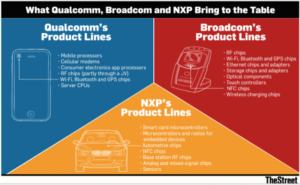In case you missed it, 5G is at the root of the recent headlines of the US Treasury Dept. scuttling a “$121B hostile Chinese takeover bid” (to the Singapore-based Broadcom) of mobile chip maker, Qualcomm. The next generation wireless standard promises fiber optic-like speed and Gigabit per second downloads in the palm of your hand, and the technology goes way beyond connecting consumer mobile devices.

5G is not just for consumer mobile connectivity. The technology was identified in a US national security strategy document last December that stated: ““We will improve America’s digital infrastructure by deploying a secure 5G Internet capability nationwide.” Perhaps even more striking, a proposal to ‘nationalize” the build-out of a wireless 5G network was the subject of a national security council memo that resulted in the departure of its author from the council over its eventual leak to press.
Meanwhile, 5G is at the core of Qualcomm’s growth going forward with as many as 19 device makers, and 18 wireless carriers having committed to its technology for the upcoming move to 5G, according to a San Diego Union Tribune story. The wireless carriers include AT&T, Verizon, Sprint and T-Mobile, all using Qualcomm’s Snapdragon X50 chips for 5G trials. Mobile device makers on the Qualcomm track including LG, Sony, HTC, Asus, ZTE and Xiaomi devices. No wonder Broadcom is licking its chops at the prospect.
Just days earlier, on March 12, Broadcom announced it’s first 5G radio switch that looks to move cellular base stations to a terabit (TB) ethernet radio that connects directly to existing LTE networks as well as the next generation 5G radios that are set to dominate the future of mobile connectivity.
Dubbed the Monterey Ethernet switch, Broadcom’s BCM 56670 targets cellular’s frontal networks, is compatible with new 5G IEEE standards (as they exist today under the 802.1CM) and simultaneously supports the common public radio interface (CPRI) based radios. That brings together all the standards. Additionally Monterey shares a set of common API interfaces with other Broadcom switching products via the SDK, (Broadcom’s Software Development), making it easy to move to a Broadcom-based standard, the company says will “minimize development effort and accelerate system introduction.”
And that’s just the point. The US Treasury is a bit concerned over a company based outside the US setting next generation standards for the US (and international) 5G network build-out that would most certainly come if Broadcom were to merge with San Diego, CA based Qualcomm technology. The US-based company, which also holds top secret prime contracts with the US government, is also looking to dominate this next generation cell network space.
The Broadcom 5G radio chip announcement states, “The 5G build-out will require an increase in capacity of the mobile network by a factor of ten or more and a simultaneous tightening of key synchronization requirements by a factor of two or more. Ethernet technology is very high capacity, but in the past it has not met the strict synchronization and jitter requirements of cellular networks. The IEEE’s new 802.1CM (Time-Sensitive Networking for Fronthaul) standard provides a synchronization solution that solves this problem and the cellular network can now be upgraded to an end-to-end Ethernet-based architecture that meets the cost, capacity, and performance requirements of 5G.”
According to Linley Group analyst Bob Wheeler, this is a “unique solution” developed by Broadcom, created by “…extending its terabit Ethernet switch to address this new radio fronthaul application by adding support for Ethernet-based 5G radios as well as installed CPRI-based LTE radios,” he said in a recent WSJ article on the announcement. He sees a switched Ethernet infrastructure based on new protocols including eCPRI and IEEE 1914 as the way forward over existing point-to-point CPRI radio links.
Suffice it to say that 5G network build is in the wings, with its terabit per second download speeds that blow away megabit levels by. well, orders of magnitude. Truth be told, even 100 Mpbs is a blessing and hard to find in most home wi-fi domains, let alone coffee shop, library or other public venues. But rest assured the US government is on the job working tirelessly to “secure our domestic tranquility…” by keeping those pesky foreign-owned companies from buying up our chip makers; and isn’t that a comforting thought? — Stephen Sechrist
5G Is Everywhere – But Who is Looking at ROI?
ZTE Pushes for 5G But Has 1.2Gbps
Qualcomm Boosting Wireless and Shows VR Platform
Qualcomm Increases Offer for NXP
Broadcom Calls Off Qualcomm Bid
KT,Verizon and Samsung Collaborate on 5G Solution Demo
IRT Commences 5G TV Broadcast Research Project
VR Head-Mounted Displays Will Use WiGig and 5G by 2022

